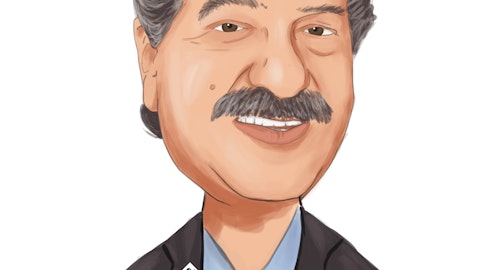Steven Lin: Thank you, management for the presentation. I have two questions. First, could you please talk more about Quentn [ph] software and the Telescope’s application and the impact? Second, how should I think about 111’s top-line growth in the next few quarters and what are the key drivers? Thank you.
Junling Liu: I will take the first one and Haihui will take the second one. So, let me talk about the few products, digital products you mentioned, like Quentn, you mentioned Telescope, etcetera, okay. These are all digital products we developed to serve our customers, okay. For example, Telescope is a SaaS service to pharmaceutical companies. Basically, it’s used to help them monitor the entire supply chain, making the supply completely transparent. They include their product flow through various distribution and retail channels in various regions. The end customer profile, behavior as well as inventory turns and repurchase rates, etcetera, all of those data are made transparent to pharmaceutical companies. And these are used to facilitate their decisions in production, in new product development and in channel allocation.
You also mentioned Quentn and Hot Whale [ph]. These are services to our JDP and the marketplace partners. They are used to assist them in more efficient, procurement and logistics. By leveraging these services, we have seen remarkable growth of GMV for these partners, much higher than our overall growth, like more than 40% higher for these partners. So, in turn, they help us to enrich our selection and price competitiveness, so it’s a win-win.
HaihuiWang: And regarding your second question on growth and also the growth drivers. I think first, from industry-wide as Junling just mentioned, the government strategy of separation of drug sales from the hospitals’ medical treatment is going on, including recently, as you may be aware, and there is also a national-wide anti-corruption in our medical area. So, the execution of the government strategy of separation definitely is very favorable to us as the separation of the drug sales from hospital, meaning it will go to the retail market. And the drug sales in hospital is, we are talking about RMB1.2 trillion, so the overall pharmaceutical retail will get benefits, including us. And also internally, first, we will continue to upgrade our supply chain.
We will establish, further strengthen our direct strategy partnership with more and more international and domestic partners to bring more selection with lower and lower cost to our downstream customers. Secondly, we will enhance our digital marketing platform to help pharmaceutical companies to commercialize their new products to pharmacies, clinics and eventually to those patients and customers. So, in my view, our B2B business is becoming the platform to effectively link pharmaceutical companies with pharmacies, clinics and with the end users. Last year, the volume of China pharmacy retail has exceeded RMB600 billion. And as I have mentioned just now, more and more are moving out from hospitals. So, it’s a very, very big market and we believe we have enough room to further expand our business volume with a healthy margin.
Thank you.
Steven Lin: Okay. It’s very clear. I appreciate your answers.
Operator: The next question comes from Francis Juan with VSV Capital. Please go ahead.
Unidentified Analyst: Hi. This is Francis from VSV Capital. Congrats again on a great quarter. I have got two questions. The first one is what kind of assistance and impact does your company’s digital capabilities have on the industry. The second one, what will be the company’s operational focus going forward? Thank you.
HaihuiWang: Thank you, Francis. So, let me take the first question. We define ourselves as the digital enabler in the healthcare industry. We have invested heavily in the digitization of the industry in the areas for supply chain, patient education, medicine availability, patient reach and health management. We set our mission to leverage our digital technology to effectively link patients with the healthcare services, and we are on target – on track to realize that. Junling in his report, mentioned the listing of our 111 information on the Shanghai Data Exchange, that’s a perfect example. So, our master data in the pharmacy industry includes more than 720,000 main product data and 1.2 million company data, currently 99.6% of the whole pharmaceutical market. So, this data will play a very important role in drug flow tracking, drug initial information entry and the compliance for e-commerce pharmaceuticals.
Junling Liu: And I will answer Francis’ second question with the operating focus. I would – in a very simple language, it would be two areas. One is to grow revenue and margin. And two is to really drive operational efficiency. If I could elaborate a little bit, how do we grow, as I spoke in my script, obviously, we are going to use JDP to enrich our selections. And for our first-party products, we want to get a much better alignment with customers’ preferences. Internally, we have built up an intelligent system called BeiGene, which collects information from our own internal daily operations and also the intelligence comes from our salespeople on the ground and also from industry-wide sources. And that would ensure that we can have a much better assortment, a much concise and precise assortment for our customers.
Therefore, with that, we can provide a one-stop shop experience for our customers. And in terms of growing margin, of course, I spoke about our intelligent pricing system. And of course, in the past, we always used human to do the pricing. And now we are shifting majority of the pricing into machines. Let the machines learn and we feed the machine with all the necessary data and let the machine make the right choice. And if it is wrong, they can learn and readjust. And the other thing I mentioned about driving margin is to really bring cost down. And of course, we are solidifying our supplier base and our procurement team has a very clear specific task on reducing the procurement cost pretty much across the board. And we have internal meetings on a regular basis, at least weekly to look into those numbers.
When it comes to drive operational efficiency, of course, we have only literally three buckets of expenses. One is fulfillment. The other one is sales and marketing and the last one is G&A. And obviously, I spoke a lot about fulfillment, and we have really proven the effectiveness of our measures and our fulfillment cost came down to 2.7% versus 2.9%. And obviously, when it comes to sales and marketing, we are doing a fantastic job there, very, very noticeable change in the G&A as well. So essentially, what we are doing is to really invest in technology. We use technology to become much, much more efficient. Once we can operate with sub-6 and sub-5 operational expenditures, we are already the industry’s best. If you look across the board, I don’t see anybody can operate at our rate of operating expenditure today.
And we are not going to stop there. We are going to continue to bring the expenditures down. Therefore, we cannot actually be a much more profitable company. Thank you, Francis.
Unidentified Analyst: Thank you. Both answers are very clear and we look forward to hearing more.
Operator: The next question comes from Jada Wu [ph] with Arbor Group Capital. Please go ahead.
Unidentified Analyst: Hi everyone. This is Jada Wu from Arbor Group Capital and congratulations on the company’s success and growth in Q2. Here, I have got two questions. The first question is, what is a reasonable margin level in the next 3 years to 5 years? How can we further expect margin? Thank you.
Luke Chen: Yes. Well, regarding margin, our strategy was more and more healthy business model and it has been working well. And we are seeing a significant improvement on our product margin. And there are a couple of initiatives going on in this area. One is to reduce our procurement cost through direct sourcing from pharmaceutical companies. And we are now sourced from over 500 global or domestic, those are big pharmaceutical companies. And we will continue to strengthen our partnership with them. And the second one is – the second lever is we can pull to improve margin is through our product assortment optimization. Currently, with the annual sales revenue of over RMB13 billion, also with the 400,000 pharmacies in our platform, we are now in a position to balance our portfolio of products and fund those high velocity, but low-margin products together with healthy ones.





